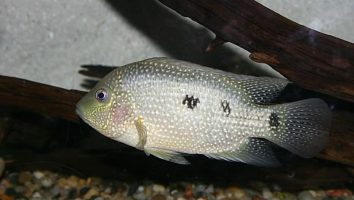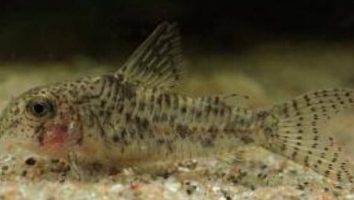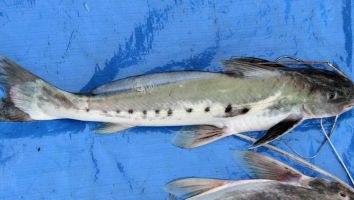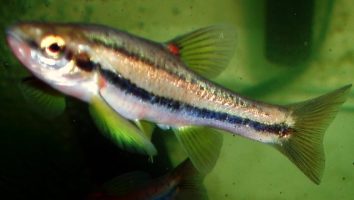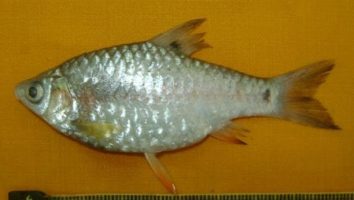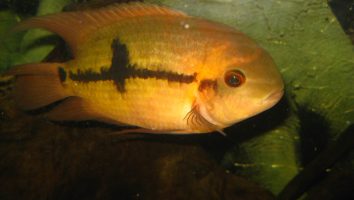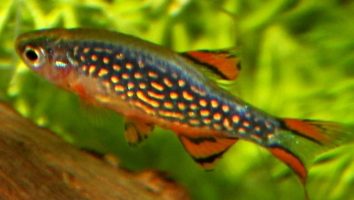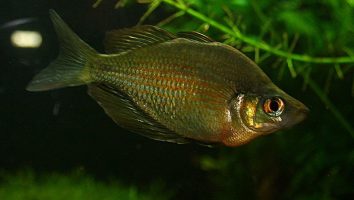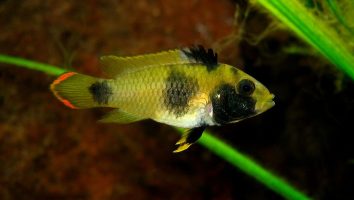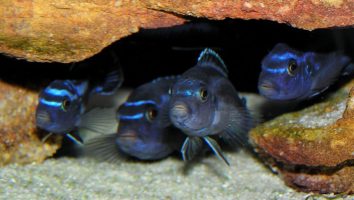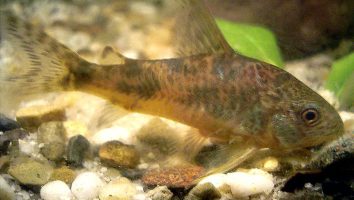The checker barb is a beautiful freshwater fish that is perfect for the beginner aquarist. They are easy to care for and are very peaceful, making them a great addition to any community tank.
Despite their peaceful nature, checker barbs are still active fish and need plenty of space to swim. They are also known to be fin nippers, so it is important to provide them with plenty of hiding places and places to explore in their tank.
This guide will teach you everything you need to know about checker barb care. You’ll learn about their diet, size, lifespan, and more!
Table of contents
Species overview
Checker barbs (Puntius oligolepis) are a schooling fish that is found in parts of Thailand, Laos, and Cambodia. They prefer still or slow-moving waters with plenty of vegetation.
This fish gets its name from the black and white checkerboard pattern that is found on its body. These fish grow to be about 3-4 inches long and are a popular choice for many aquariums.
Checker barbs are peaceful fish but can be territorial with their own species. It’s important to have a good ratio of males to females if you want to avoid any fighting.
These fish are easy to care for and are a good choice for beginner aquarium owners.
Appearance
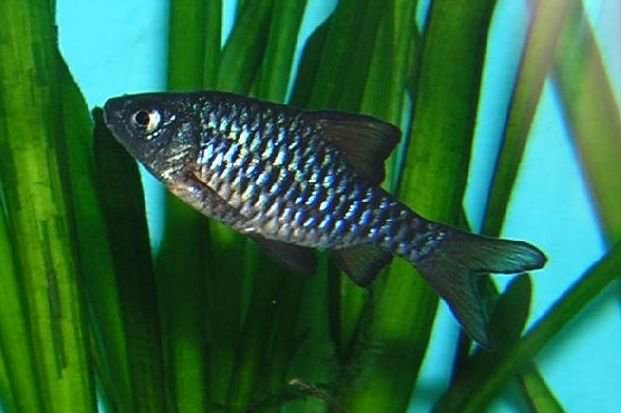
The Checker Barb is a beautiful fish that really stands out in a tank. They are a golden color with black spots that cover their entire body. These spots are more prominent on the upper half of the fish and get lighter as they go down the sides.
The fins on this fish are also quite striking. The dorsal fin is large and starts about two-thirds of the way back on the body. It has a black and white checkerboard pattern that is quite eye-catching.
The anal fin is also large and starts about halfway back on the body. It has the same checkerboard pattern as the dorsal fin.
The caudal fin is forked and also has the black and white checkerboard pattern.
The pectoral and ventral fins are small and black.
The Checker Barb is a very active fish that loves to swim. They are always on the move and exploring their surroundings.
Lifespan
The average lifespan of a Checker barb is 5 to 8 years. However, there are a number of factors that can impact their life expectancy.
As with any other fish, the level of care they receive is very important. These fish are fairly hardy, but if they’re kept in poor conditions their lifespan will be significantly shortened.
Another important factor is whether or not they’re wild caught or captive bred. Wild caught fish are usually not as hardy as captive bred fish and their lifespan will reflect that.
Size
These fish can reach a size of up to 6 inches (15 cm) long.
Tank
Tank Size
The recommended tank size for a checker barb is at least 30 gallons. This is assuming you’re only keeping one fish, which is not recommended. If you want to keep a school of checker barbs, you’ll need at least a 50-gallon tank.
Keep in mind that these fish get fairly large, so even if you’re only keeping a school of three or four fish, you’ll still need a fairly large tank.
Water Parameters
Checker barbs are a little more demanding when it comes to water parameters. They come from fast-moving waters in Southeast Asia.
To replicate those conditions in the home aquarium, you need to start with the basics.
First, the water should be on the cooler side. A checker barb tank temperature in the low to mid-70s is ideal. They can tolerate a wider range, but that’s the sweet spot.
The next thing to consider is water movement. A good filter will help create a little bit of flow, but you may need to supplement it with an additional powerhead or two. The checker barb prefers a little more water movement than some of the other fish on this list.
- Water Temperature: 72-79 degrees Fahrenheit
- pH Levels: 6.5-7.5
- Water Hardness: 8-20 dGH
- Alkalinity Levels: 4-8 dKH
What To Put In Their Tank
The Checker Barb is a schooling fish, so you will want to keep them in groups of at least 6. They are peaceful fish but can be nippy, so it is best to avoid keeping them with fish that have long fins.
When it comes to plants, they are not too picky. They will nibble on soft plants but will not uproot them. So, you can use either live or fake plants in their tank. Just make sure that the plants are not poisonous to fish.
For the substrate, you can use either sand or gravel. We prefer sand because it is easier on their barbels.
As for decorations, you can use anything that is safe for fish. Driftwood, rocks, and caves are all good choices. Just make sure that the decorations are not too small, as the Checker Barb may try to eat them.
Common Diseases
The Checker Barb is a hardy fish that doesn’t often fall ill. However, when they do get sick it’s usually due to one of two things: ich or hole-in-the-head disease.
Ich is a very common freshwater fish disease that is caused by a parasite. The most obvious symptom of ich is the presence of white spots on the body of your fish.
If left untreated, ich can be fatal. However, it’s usually fairly easy to treat with medication (you can find ich medication at your local pet store).
Hole-in-the-head disease is another common ailment in freshwater fish. It’s caused by poor water quality and the presence of activated carbon in the tank.
This disease presents itself as one or two pits/holes in the skin of your fish’s head. While it’s almost always curable, it will usually leave some scarring on your poor fish!
To prevent your Checker Barb from getting sick, it’s important to maintain a clean and healthy environment. This means regular water changes and close attention to the quality of the water in your tank.
Behavior & Temperament
Checker barbs are peaceful fish that get along well with others, as long as those others are not of their own species. These fish are known to be pretty nippy, especially when they’re kept in small groups. That’s why it’s best to keep them in schools of six or more.
Even when they’re not nipping, checker barbs are active little fish that are constantly on the move. They’re very curious and love to explore their environment. This makes them fun fish to watch, but it also means they need a lot of space to swim. A small tank just won’t cut it for these guys.
Checker barbs are also known to be jumpers, so it’s important to have a tight-fitting lid on their tank.
Tank Mates
Checker barbs are a schooling species, so they need to be kept in groups of at least six. It’s best to have more, though, since these fish are quite active.
A group of 10-12 checker barbs is ideal. This will give them enough of their own species to school with while also allowing them to mix with other fish in the tank.
When it comes to compatibility, checker barbs get along with most fish. They’re not overly aggressive, and they’re not on the menu for most predators.
Here are some good tank mates for checker barbs:
- Guppies
- Platies
- Mollies
- Swordtails
- Danios
- Tetras
- Rasboras
- Corydoras Catfish
Breeding
The checker barb is a relatively easy fish to breed in captivity. They are an egg-laying species, so the process is fairly straightforward.
As with most fish, you’ll need to start by sexing the fish. Males and females have some subtle differences. Males are typically larger and have more coloration. Females tend to be a bit drab in comparison.
Once you’ve sexed the fish, you can begin setting up the breeding tank. It should be at least 30 gallons and well-filtered. The water should be slightly acidic with a pH of around 6.5. The temperature should be between 72 and 79 degrees Fahrenheit.
As you’re setting up the breeding tank, be sure to add plenty of hiding places. This species likes to spawn in caves and crevices. Rocks, driftwood, and plants all make good spawning sites.
When the tank is set up, you can add the fish. Start with two females for every male. Once they’re in the tank, feed them plenty of live foods.
When the fish are ready to spawn, you’ll see the female lay her eggs in a chosen spawning site. The male will then fertilize them. Once the eggs are fertilized, the male will guard them until they hatch.
Eggs usually hatch in about a week. When they do, you can remove the adults and begin feeding the fry baby brine shrimp.
Conclusion
Checker barb care is pretty easy and straightforward. These fish are very hardy and can adapt to a wide range of water conditions.
They’re also relatively peaceful, making them a great addition to community tanks.
The only thing you really need to be aware of is their potential size. Make sure you have a tank that can accommodate them when they’re fully grown!
Other than that, we think checker barbs are great fish and we’re sure you will too.

